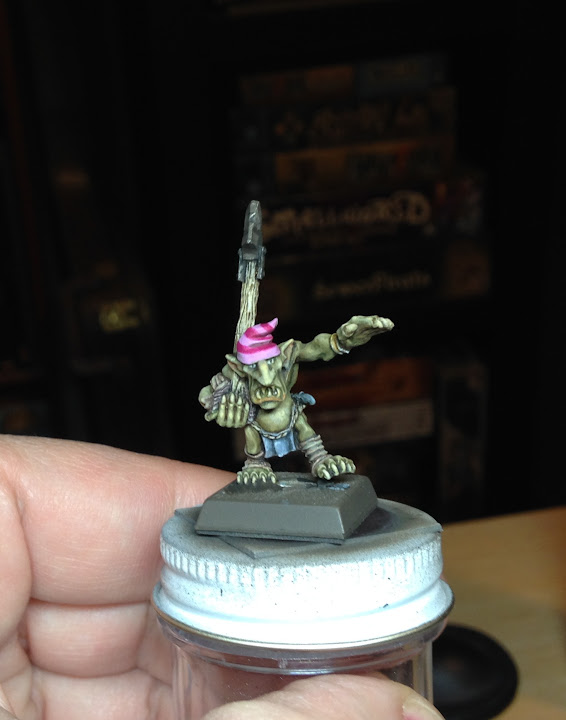I played my first two games of Frostgrave this weekend. The "local meta" is considering adopting Frostgrave into its collective rotation, so my regular opponent, Chris, and I took it for a spin, followed up with a game with Sid, this being Sid's first introduction to a proper miniatures game.
The premise of Frostgrave is a face-off between small warbands of up to 10 figures, led by a wizard and his/her apprentice, as they explore the ruined city of Frostgrave, in search of magical knowledge and treasure. In essence, the game is a "dungeon-dive", a campaign-driven skirmish-game in the vein of Mordheim.
The rules are quick-to-learn, a common feature of modern game design, thankfully. The rules are unapologetically loose -- the game is intended as a light-weight, casual game, so the rules don't place a lot of weight on precision or rigor. For the narrative gamer, though, the rules certainly get the job done.
One primary feature of the game is the campaign system. The game is intended to be played over successive sessions, allowing wizards to gain experience and improve their gear, capabilities, and henchmen. The rulebook offers 10 scenarios from which to choose each game. Some are based off of a "standard scenario", where players alternate placing 3 treasure tokens each, 9" or more away from their respective table edges.
Some things I like about the game:
- Quick-to-learn.
- Lends itself to using miniatures from your own collection.
It's fun to form a theme for the warband, based on the wizard and his/her school of magic, from the available 10 schools of magic. For example, some of my favorite miniatures from my own collect, for whom I've enjoyed personifying in games past, include: Old Man Tumbergrumbler, the goblin shaman; various Swamp Hags, including a classic Talisman miniature, and Zoraida, from Malifaux; my classic Talisman wizard; and Grand Mistress Pontifica, the Dark Elf Sorceress.
- It's fun to select spells to tailor the warband.
I like that the selection must be spread across several schools of magic, with varying levels of competency. Tailoring the spells and the warband further embellish the character of the wizard. The first spell I picked for Old Man Tumbergrumbler was 'Mud'. It was a must-have. Same for the Swamp Hags, along with the ability to summon Swamp Shamblers.
- Quick pace and decisive combat.
The core mechanics are quick to execute. The game has an easy flow, and it makes good narrative sense. I like how either side can win a melee. It feels like an improved version of the combat mechanic from Lord of the Rings Strategy Game.
- Wandering monsters.
A nice, random element to throw a twist into everyone's plans. And it's an excuse to bring even more characterful models from your collection onto the tabletop.
I find Frostgrave to be a fun, light-hearted game, and it feels very "comfortable", in its pace, mechanics, and narrative. I think the game does have one minor flaw, however, and that is the basic scenario. From a pure, practical standpoint, the warbands have little motivation to interact. Each warband could simply run forward, grab their nearby 3 treasures and exit the board. Neither player "wins" the game, but both players advance their warband for the next game in the campaign.
 |
The Swamp Hag directs her goblin archer to shoot the enemy Apprentice.
Old-skool Orcs take the fight to nu-skool Hadross jelly-fish men from Wrath of Kings.
Old Man Tumbergrumbler surveys the city for loot, while a lazy goblin archer scratches his bum. |
Narrative players will typically make their own excuses to interact and gain an edge over the opponent(s). But where Frostgrave seems to keep to modern game design in many areas, it falls short in keeping to modern scenario design. At a minimum, I would expect some forcing function to motivate the warbands towards the centerline or even into enemy territory. Some of the 10 scenarios do add such mechanics as embellishments, but I would think the standard scenario would have such a mechanic as a necessary element. As it stands, I think to make the game more compelling, Chris and I will need to house-rule an enhancement or a change to the basic scenario.
 |
In the game against Sid, Grand Mistress Pontifica lords over the battlefield.
A wandering troll struggles through the Mud, frustrated at being unable to reach all the tasty morsels littering the battlefield. |
Overall, I find the appeal of Frostgrave about on par with Regiments of Renown, the Warhammer skirmish game that GW published a couple of years ago. I suspect I would be just as entertained playing Otherworld, Mordheim, Song of Blades and Heroes, Fantacide, Dragon Rampant, Arcworlde, and other similar lightweight, fantasy, skirmish games.
Which leads to a final question that I have. I find it a mystery that Frostgrave has enjoyed so much success. I don't think it offers a significant differentiator from those other games. I suspect that the reason is that Frostgrave's publisher, Osprey Games, has better market penetration than any of those other competitors. Osprey has brand recognition; they have cross-over appeal to the historical players; and they have presence in a greater variety of venues than just game stores, being present in hobby stores, book stores, and on-line stores.
Does anyone else have any different theories on Frostgrave's popularity, relative to its competition?






















